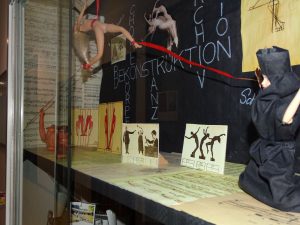The century of the dance (2019)

With this exhibition from 24 August to 21 September 2019 under the motto “Was der Körper erinnert. Zur Aktualität des Tanzerbes” (English: What the body remembers – The relevance of the dance heritage), an attempt was made at the Academy of Arts in Berlin to build a bridge between the tradition of modern dance in Germany, which already spans more than a hundred years, and contemporary dance practice on the basis of selected collections from the dance archives.
A showcase on the Tanzarchiv

As part of a seminar by Dr Melanie Gruß on the holdings of the Tanzarchiv Leipzig, a display case in the long corridor of the Institute of Theatre Studies (Ritterstr. 16, 04109 Leipzig) was filled with selected objects. This new “permanent exhibition of the temporary” exemplifies how students today can engage with the themes and material remains of dance history and its documentation.
Memorial exhibition for Uwe Scholz at the Leipzig Opera House (2014)
On the 10th anniversary of Uwe Scholz’s death on 21 November 2014, a special programme entitled Danke Uwe Scholz (English: Thank you Uwe Scholz) took place at the Leipzig Opera House, which included the opening of an exhibition of films and posters of choreographies by Uwe Scholz, developed in collaboration with the Tanzarchiv Leipzig e.V..

Poster exhibition Folk Dance in the GDR (2013)
As part of the project HEUTE: VOLKSTANZEN (English: TODAY: FOLK DANCE), the exhibition in Hamburg and Leipzig showed the diversity of folk dance as a cultural practice. A selection of posters on folk dance in the GDR from the holdings of the Tanzarchiv Leipzig e.V. documented announcements of events from the years 1954-1988. In addition, film clips from the Sorbian Cultural Archive were on display, contrasting with Olaf Marten’s photographic stagings of folk dance groups today.
Body politics (2012)
Accompanying the international conference Body Politics: Rhythmics, Modern Dance and Movement Choirs in HELLERAU the exhibition showed the development of amateur dance and movement choirs in the 1920s up to the mass choreographies of the Nazi era. It focussed the work of Rudolf von Laban, who is considered one of the founders of modern dance and whose partial estate can be found in the Tanzarchiv Leipzig.
Imaginary archive in the white cube (2010)
During the play!LEIPZIG festival, an imaginary archive was installed in the white cube in the basement of the Schaubühne, which could only be explored through a small window and aroused great curiosity among the numerous visitors.
